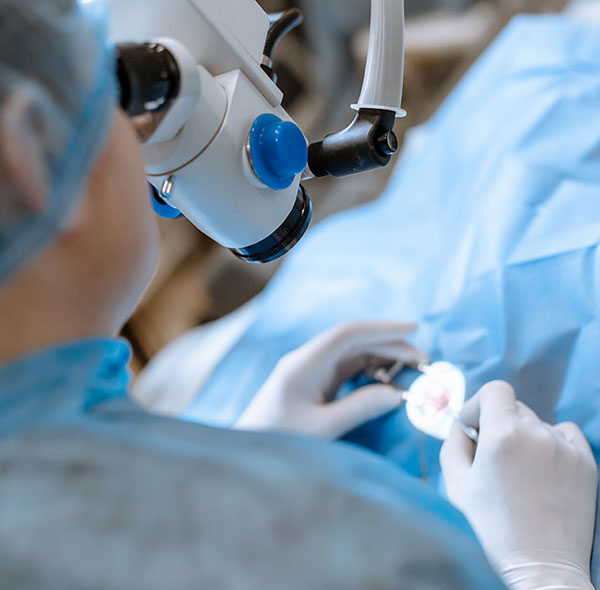Anesthesia Options
for Office-Based Surgery
Anesthesia Options for Office-Based Surgery
|
|
|
|
Type of Anesthesia
|
Oral and Topical
(Midazolam, Diazepam, MKO Melt) |
IV
(Versed, Fentanyl) |
|
Use in OBS cases
|
99%
|
1%
|
|
Pre-Op Requirements
|
None
|
|
|
Post-Op Requirements
|
None
|
Patient monitoring by a licensed anesthesia provider
|
|
Space Requirements
|
|
|
Level of Anesthesia Should Be the Surgeon’s Choice
An ophthalmologist has the highest level of professional training of any physician regarding the eye. That said, he/she is uniquely qualified to provide medical clearance and determine the appropriate level of anesthesia for each patient. In many ASCs or HOPDs, policies do not allow oral sedation. More often than not, surgeons face barriers that prevent them from choosing what is appropriate for each patient.
In the next ten years, the number of anesthesia providers is expected to drop by 30%, and that will impact the ability of some ASCs to perform surgery. That’s why it’s more important than ever that surgeons control their surgical decisions. That said, 99% of OBS cases are performed with oral sedation which does not require a licensed anesthesia provider.
Oral Sedation: A Safer Option for Cataract Surgery

Office-based procedures are just as safe as procedures performed in any other setting because the level of anesthesia is entirely appropriate to the level of care being provided. Benefits of oral sedation include:
-
Breathing response is less decreased
-
Lower medical risks (e.g., less oversedation)
-
Less postoperative nausea/vomiting
-
Less undesired patient movement
-
Better patient cooperation
99%
of OBS Cases are Safely Performed with Mild Sedation
In iOR Suites, 99% of cases are performed with oral sedation and have safety outcomes that meet or exceed those in other settings. Patients over 65 had overall occurrence rates similar to the total cohort. In fact, a growing amount of research shows that mild sedation is typically a better course of treatment for the patient.
Source |
|
|
|
|
|
|
|
Journal of Cataract & Refractive Surgery
|
Fewer patients receiving oral Diazepam 30 minutes before cataract surgery than patients receiving IV midazolam immediately preceding surgery showed undesired movement during surgery. There was no statistically significant difference in the number of patients showing poor cooperation or experiencing pain or anxiety between the two groups.
|
|
|
Ophthalmology
|
CCataract surgery can be safely performed in an outpatient clinic without anesthesia, and with limited workup and monitoring. Basic first aid and basic life support skills seem to be sufficient in case of an adverse event. An MET provides a generous failsafe for this low-risk procedure.
|
|
|
Ophthalmology
|
Although claims and suits were infrequent given the large number of insured ophthalmologists and the large number of surgical cases requiring various types of anesthesia performed over the 10.5-year study period, severe injuries can occur.
|
|
|
Clinical Ophthalmology
|
Results suggest that an initial dose of oral Triazolam is equivalent to IV Midazolam for non-cataract anterior segment surgeries. However, there was a relatively high need for supplemental IV anesthesia during some surgery types, particularly with glaucoma tube shunt implantation.
|
|
|
American Journal of Ophthalmology
|
A retrospective review of resident-performed cataract surgeries at a VA (n ~ 1000) using oral sedation (without anesthesia monitoring) showed zero supplemental IV sedation was needed.
|
Preoperative IV catheter placement may not be necessary in patients undergoing routine resident cataract surgery with preoperative oral sedation. Discontinuation of routine IV placement may improve patient satisfaction and decrease healthcare costs without compromising patient safety. |
|
American Society of Retina Specialists
|
Patient Satisfaction With Oral vs: Intravenous Sedation for Vitrectomy Surgery: A Randomized, Noninferiority Clinical Trial | Patient satisfaction with oral sedation was non-inferior to IV sedation for vitrectomy surgery. |
|
Scientific Reports
|
Ambulatory cataract surgery centre without perioperative anesthesia care: a prospective cohort study | The procedure described in the study represents a simplified, safe, and satisfying care pathway for screened patients eligible for cataract surgery under topical anesthesia without the following elements: preoperative assessment or blood test, anesthetic visit, modification of the usual treatments, preoperative fasting, venous line, or intravenous sedation. |
|
Gangadhar B. Presentation at Kansas EyeCon 2019
|
Cataract Surgery: The Road to Fiscal Sustainability: The Promise of the Triple Aim. | Mounting evidence supports the fact that cataract surgery can be performed with milder forms of sedation. This is without any tradeoff in safety, whereas higher classes of anesthesia are often associated with a higher risk of complications. |